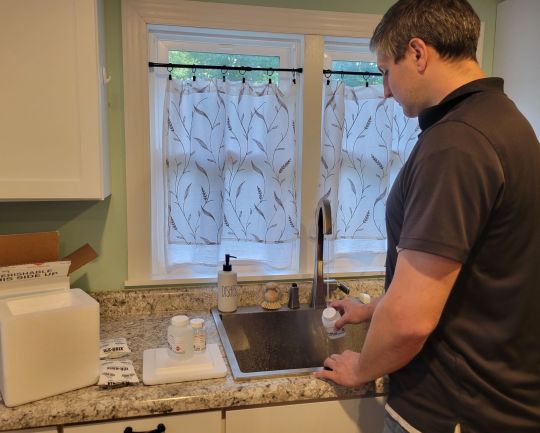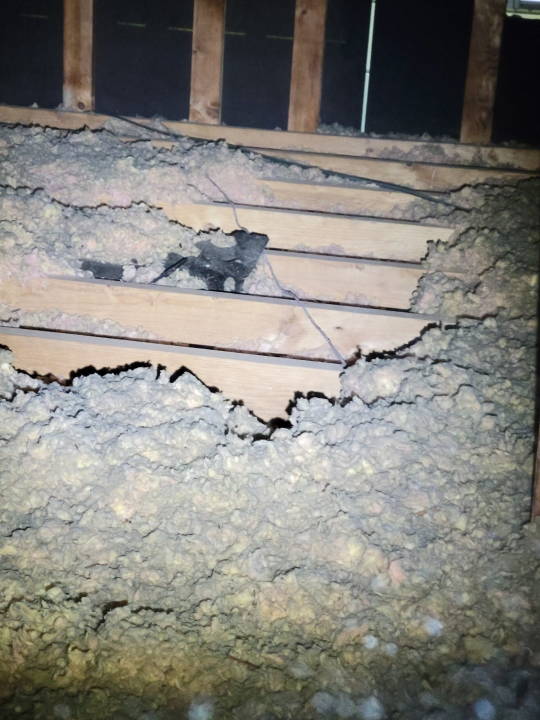Text
Well Water Testing: Ensuring Safe and Healthy Drinking Water
As homeowners, we often take for granted that the water flowing from our taps is safe to drink. However, the truth is that the Environmental Protection Agency (EPA) only regulates public water systems, leaving the responsibility of ensuring the safety of private drinking water wells in our hands. This is why well water testing is crucial in order to know if our water is safe for consumption.

Table of Contents
Well Water Testing: Ensuring Safe and Healthy Drinking Water
Why is Well Water Testing Important?
What Does Well Water Testing Involve?
The Process of Well Water Testing
Understanding the Test Results
The Importance of Well Water Testing for Your Health
Resources for Well Water Testing
Why is Well Water Testing Important?
If your home relies on a private well for its water supply, it’s essential to ensure that there are no issues compromising the quality of the water. This is especially important if the well is old or shallow, as they are more prone to contamination. It is also recommended to conduct a water test if there are young children, older adults, pregnant or nursing individuals living in the home, as they are generally more vulnerable to bacteria and pollutants.
Even if there are no specific risk factors, changes in the taste, odor, or color of the water should not be ignored. These changes can be indicators of underlying issues that may affect the water quality. Addressing these changes promptly through well water testing can help identify potential contaminants and ensure the safety of your drinking water.
What Does Well Water Testing Involve?
During a well water test, various parameters are assessed to determine the quality of the water. These parameters include bacteria, nitrates, fluoride, arsenic, lead, and copper. By sampling and analyzing the water, a comprehensive understanding of its safety can be obtained.
It is important to note that well water testing is not a one-time event. Regular testing is recommended to ensure ongoing water quality. The frequency of testing may vary depending on the specific circumstances, but as a general guideline, it is advisable to test your well water at least once a year.
The Process of Well Water Testing
Sample Collection: The first step in the well water testing process is to collect a representative sample of the water. This is typically done by following specific guidelines provided by certified professionals. It is crucial to ensure that the sample is collected in a clean and sterile container to prevent any external contamination.
Laboratory Analysis: Once the water sample is collected, it is sent to a certified laboratory for analysis. The laboratory will conduct tests to measure the presence of bacteria, nitrates, fluoride, arsenic, lead, copper, and any other parameters that may be relevant to the specific circumstances of your well.
Test Results: The test results are usually available within a week of sampling. These results will provide detailed information about the quality of your well water, indicating whether it meets the safety standards for drinking water.

Understanding the Test Results
Interpreting the test results can sometimes be challenging, especially if you are not familiar with the various parameters and their acceptable levels. This is where the expertise of a certified home inspector can be invaluable.
As an InterNACHI certified home inspector, I am trained to conduct well water testing and help homeowners understand the implications of the test results. With my experience and knowledge, I can guide you through the process, explaining any potential concerns and offering recommendations for remediation if necessary.
The Importance of Well Water Testing for Your Health
The quality of the water we consume has a direct impact on our health and well-being. Contaminated well water can pose serious health risks, especially for vulnerable individuals such as children, the elderly, and pregnant or nursing women.
Bacteria in water can cause gastrointestinal illnesses, while high levels of nitrates can lead to a condition called methemoglobinemia, or “blue baby syndrome,” which affects the ability of blood to carry oxygen. Arsenic, lead, and copper are toxic metals that, when present in high concentrations, can have detrimental effects on various organs and systems in the body.
By conducting regular well water testing, you can identify potential contaminants early on and take the necessary steps to ensure that your drinking water is safe.

Resources for Well Water Testing
If you are unsure about how to go about conducting well water testing or want to learn more about it, there are several resources available that can provide valuable information and guidance.
The InterNACHI Association of Home Inspectors offers a comprehensive resource on private water wells, providing in-depth knowledge and insights on the subject. You can access their resources here.
The Centers for Disease Control and Prevention (CDC) also provides valuable information on private well water testing and maintenance. Their website offers guidance on how to test your well water and what to do if issues are identified. You can find their resources here.

Ensuring the safety of your drinking water should be a top priority as a homeowner. Well water testing is the only way to know if your water is safe for consumption, particularly if you rely on a private well. By regularly testing your well water for bacteria, nitrates, fluoride, arsenic, lead, and copper, you can take proactive steps to protect your health and the health of your loved ones.
As an InterNACHI certified home inspector, I am committed to providing comprehensive well water testing services. I have the expertise and knowledge to guide you through the process, interpret the test results, and offer recommendations for remediation if necessary. Contact me today to schedule a water test or to learn more about ensuring the safety of your drinking water.
0 notes
Text
Don’t let Missing Insulation Lead to High Energy Bills
Invest in Proper Insulation for Your Home
When it comes to maintaining a comfortable and energy-efficient home, having proper insulation is crucial. Insulation not only helps to regulate the temperature inside your home but also plays a significant role in reducing your heating and cooling costs. In this article, we will explore the importance of insulation, how it can impact your energy bills, and why investing in a home inspection and energy assessment is crucial for ensuring that your home is properly insulated.
The Benefits of Insulation
Insulation is like a protective shield for your home, providing resistance to heat flow and keeping the temperature inside stable. By preventing heat from escaping during the colder months and entering during the hotter months, insulation helps to reduce the workload on your heating and cooling systems. This, in turn, leads to significant cost savings on your energy bills.
But insulation isn’t just about saving money. It also enhances the overall comfort of your home. By creating a barrier against outside elements, insulation helps to maintain a consistent temperature throughout your living spaces. This means no more drafts, cold spots, or hot zones. With proper insulation, you can enjoy a cozy and comfortable home all year round.
The Importance of a Home Inspection
A home inspection is a comprehensive evaluation of your property, conducted by a licensed home inspector like Justin (JD) Taggart from Taggart Inspections. During a home inspection, a trained professional assesses the various systems and components of your home, including its insulation levels. This is where missing insulation can be identified.
Identifying Missing Insulation
One of the main goals of a home inspection is to identify any areas in your home that lack proper insulation. These areas often include the attic, walls, and floors. Through a thorough examination, a home inspector can determine if your insulation levels are up to par or if there are any gaps that need to be addressed.

Energy Assessment: Testing the Airtightness of Your Home
To get a more accurate understanding of your home’s energy efficiency, it is recommended to undergo an energy assessment. An energy assessment, also known as an energy audit, involves a series of tests to evaluate the airtightness and insulation of your home. This assessment is typically conducted by a certified energy auditor like Justin (JD) Taggart, who uses specialized tools such as a blower door test and an infrared camera.
Blower Door Test: Assessing Airtightness
The blower door test is a vital component of an energy assessment. It measures the airtightness of your home by creating a pressure difference between the inside and outside. By using a powerful fan mounted on an exterior door, the blower door test helps to identify any air leaks and drafts that may be present in your home. These leaks can significantly impact the energy efficiency of your home and contribute to higher energy bills.
Infrared Camera Inspection: Detecting Insulation Issues
Another essential tool used during an energy assessment is an infrared camera. This camera helps to detect temperature variations in your home, which can indicate insulation problems. By capturing thermal images, the infrared camera allows the energy auditor to identify areas where insulation is missing or inadequate. These images provide valuable insights into the effectiveness of your insulation and guide recommendations for improvement.
The Importance of Proper Insulation
Proper insulation is not just about energy savings and comfort; it also has significant implications for the environment and your health. Here are a few reasons why investing in insulation is crucial:
Energy Efficiency and Cost Savings
By ensuring that your home is properly insulated, you can significantly reduce your energy consumption and lower your utility bills. With rising energy costs, this can translate into substantial long-term savings. Additionally, improved energy efficiency reduces the demand for fossil fuels, helping to mitigate the environmental impact of energy production.
Moisture and Mold Prevention
Insulation plays a vital role in preventing moisture buildup and mold growth. By creating an airtight seal, insulation helps to maintain dry air circulation within your home. This reduces the risk of mold formation, which can have detrimental effects on both your property and your health. Proper insulation ensures that moisture is kept at bay, promoting a healthier living environment.
Environmental Benefits
Investing in proper insulation not only benefits you as a homeowner but also contributes to a more sustainable future. Energy-efficient homes have a smaller carbon footprint and reduce greenhouse gas emissions. By conserving energy and lowering your reliance on heating and cooling systems, you are actively participating in the fight against climate change.
Remember, insulation provides resistance to heat flow and lowers your heating and cooling costs. To test the airtightness of your home and identify any insulation issues, consider getting an energy assessment. This assessment will help you determine the areas that need improvement and provide recommendations on how to make your home more energy-efficient.
By scheduling a home inspection and energy assessment, you can take the necessary steps to ensure that your home is properly insulated and ready to provide you with long-term energy savings and comfort. So don’t delay, contact Justin (JD) Taggart from Taggart Inspections today to schedule your home inspection and energy assessment.
0 notes
Text
If you're a first-time home buyer or just curious about what is included in a home inspection, take a look at this checklist to learn more!
1 note
·
View note